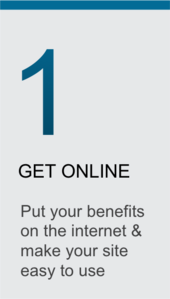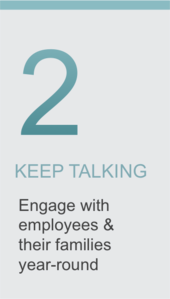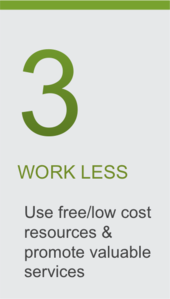
Three steps to successful employee benefits communication
The results from our Inside Benefits Communication Survey showed that in many cases, employers are failing to implement simple, proven best practices that could help them get the most value from their investment in benefits. Some key findings from the survey include:
- Employers’ top goal is executing a successful open enrollment (60 percent).
- Their biggest challenge is getting employees and families engaged year round (78 percent), followed by increasing participation in programs and benefits (50 percent).
- Few are meeting all their goals—only 24 percent.
The survey results emphasized the need for clear, actionable steps and clarity on what companies should do and where they should invest limited budgets. We’ve boiled down all the benefits communication best practices to these three simple steps. Following them will make benefits communication more effective for any organization. Here they are with lots of articles and case studies to help you figure out the best approach for your organization.
 1. Get Online
1. Get Online
The first step to getting people to pay attention to their benefits information is to make it accessible. And the best way to do that is by putting it on the Internet—outside a company’s firewall. More than 78% of Americans now use the internet—up 152% since 2000—and 66% have a broadband connection at home. And employees want their benefits on the Internet: 80% of Gen X, 75% of Gen Y and 66% of younger baby boomers.
This first step is so critical that we’ve created a new product to help companies accomplish it.
Read more about how this step works in some of our case studies:
Articles:
- Get to the decision maker: Why your benefits should go on the Internet and on the road
- Why companies should have their benefits on the Internet and why the excuses they use not to aren’t relevant
 2. Keep Talking
2. Keep Talking
The next step is to communicate with employees year round. Reminding them about benefits once a year is not enough to get employees actively engaged in decisions about their health and finances. The key to doing this is breaking information into bite-sized chunks and using the right tools—social media is perfect for simple, conversational ongoing communication.
Read more about how this step works in some of our case studies:
Articles:
401(k)
- New 401(k) disclosures coming … are your employees ready?
- Rampant cynicism + 401(k) fees = your problem
- Boost 401(k) participation with a little help from the government
CDHP
- Thinking about making the shift to full-replacement CDHP? See our checklist first
- Enrolling in a high-deductible plan isn’t the only way to be a good consumer
- Workers want to know how CDHPs work for them, not the company
Wellness and preventive care
- Getting results-based wellness right: The five rules of employee engagement
- 6 tips for making preventive care more prominent for employees
- Four essentials to launch a biometric screening
- Take advantage of New Year’s resolutions
Social media and mobile tools
- Benefits videos cover mobile apps, social media and year-round communication
- Three ways to make mobile work for employee benefits
- Success with social media for employee benefits
- Twitter: All you need to know
- Is Twitter a viable tool for employee benefits communication?
Health care reform
- Index of health care reform on our blog
- Health care reform: Crossing key messages
- What to tell your employees about health reform
 3. Work Smart
3. Work Smart
You don’t have to do it alone! Use the vast free resources at your disposal, search the Internet, read trade publications, promote free services that support your benefits strategy and have high expectations of what your brokers, consultants and vendors provide.
Read more about how this step works in some of our case studies:
This step can be so helpful. Please let us know if you know of any other great resources. You can also check out our free resources.
Work with Us
We partner with organizations that value their people first. Let’s talk.

Jennifer Benz, SVP Communications Leader, has been on the leading edge of employee benefits for more than 20 years and is an influential voice in the employee benefits industry.
